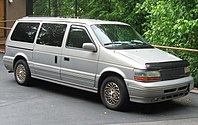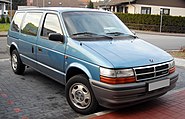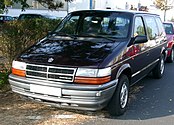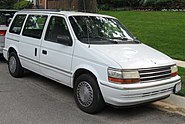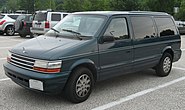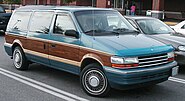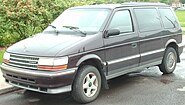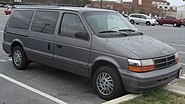
Plymouth was a brand of automobiles produced by Chrysler Corporation and its successor DaimlerChrysler. The brand was launched in 1928 to compete in what was then described as the "low-priced" market segment that was dominated by Chevrolet and Ford. It became a high-volume seller for the automaker until the late 1990s. Plymouth cars were marketed primarily in the United States. The brand was withdrawn from the marketplace in 2001. The Plymouth models that were produced up until then were either discontinued or rebranded as Chrysler or Dodge.
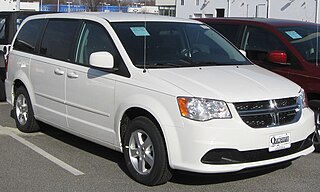
The Dodge Caravan is a series of minivans that was manufactured by Chrysler from the 1984 to 2020 model years. The Dodge version of the Chrysler minivans, the Caravan was marketed as both a passenger van and a cargo van. For 1987, a long-wheelbase Dodge Grand Caravan was introduced. Produced in five generations across 36 model years, the Dodge Caravan is the second longest-lived Dodge nameplate.

The Chrysler minivans are a series of minivans that have been produced and marketed by the American automaker Chrysler since the 1984 model year. Currently in its sixth generation, the model line is marketed worldwide, primarily in North America and Europe. Introduced as the Dodge Caravan and Plymouth Voyager, the Chrysler minivans have been marketed under a variety of nameplates under the Chrysler, Plymouth, Dodge, and Ram brands; through the use of rebadging, the model line has also been marketed under the Lancia and Volkswagen brands.

Plymouth Voyager is a nameplate for a range of vans that were marketed by the Plymouth division of Chrysler. From 1974 until 1983, the Voyager was a full-size van, sold as the counterpart of Dodge Sportsman. Starting with the 1984 model year, the Voyager was marketed as one of the new Chrysler minivan, along with the Dodge Caravan. As a minivan, there were three generations of the Voyager from 1984 until 2000. Following the closure of the Plymouth division in 2000, the Voyager was marketed under the Chrysler brand as a lower-trim version of the Chrysler Town & Country through 2003.

The Chrysler Voyager is a minivan produced by the Chrysler division of Stellantis. In the current lineup, it is positioned as the lower-end Chrysler minivan, having replaced the Dodge Grand Caravan in 2020, below the Chrysler Pacifica.

The Chrysler 300M is a full-size luxury car that was produced by Daimler/Chrysler from 1999 to 2004. It is a front-wheel drive, 255 hp V6 engined car using the Chrysler LH platform. Versus its platform mates, the 300M was roughly 10 inches (25 cm) shorter to make it more easily exportable to Europe. Priced above the Concorde and identically to the LHS, the 300M shared Chrysler's flagship position with the LHS until the LHS's discontinuation after 2001, upon which it became Chrysler's sole flagship model.

The Mercury Villager is a minivan that was marketed by Mercury from 1993 to 2002. Taking its name used by Mercury to denote its wood-trimmed station wagons, the Villager was developed in a joint venture between Ford and Nissan; the latter manufacturer marketed the line as the Nissan Quest. The first front-wheel drive van produced by Ford, the Mercury Villager was introduced between the Ford Aerostar and the Ford Windstar, competing against Chrysler minivans and the General Motors APV minivans.

The Chrysler Town & Country is a minivan that was manufactured and marketed by Chrysler from 1990 to the 2016 model years. The third Chrysler minivan introduced in North America, the Town & Country adopted its nameplate from the flagship Chrysler station wagon line, adopting its exterior woodgrain trim as a design feature for several generations.

The Pontiac Trans Sport is a minivan that was marketed by Pontiac from the 1990 to 1999 model years. The first minivan marketed by the division, the Trans Sport marked the beginning of a wider transition of moving away from sedans and station wagons as family-oriented vehicles. Marketed between the Chevrolet Lumina APV and the Oldsmobile Silhouette took its name from a similar 1986 concept vehicle.

The Ford Aerostar is a range of vans that was manufactured by Ford from the 1986 to the 1997 model years. The first minivan produced by Ford, the model line was marketed against the Chevrolet Astro/GMC Safari and the first two generations of the Chrysler minivans. Introduced shortly before the Ford Taurus, the Aerostar derived its name from its slope-nosed "one-box" exterior.

The Chevrolet Lumina APV is a minivan that was produced by the Chevrolet division of General Motors. Launched as the first front-wheel drive minivan sold by Chevrolet, the Lumina APV was sold in a single generation from the 1990 to 1996 model years. Marketed alongside the Pontiac Trans Sport and Oldsmobile Silhouette, the Lumina APV competed against the Dodge Grand Caravan/Plymouth Grand Voyager, the extended-length Ford Aerostar, and the Mazda MPV.

The Dodge Ram Van is a range of full-size vans that were produced by Chrysler Corporation from the 1971 to 2003 model years. Replacing the Dodge A100, the Ram Van transitioned to a front-engine drivetrain configuration. Mostly offered as a cargo van and a passenger van, the model line was also initially offered as a cutaway van chassis.

The Chrysler Town & Country is an automobile which was manufactured by Chrysler from 1940 to 1942 and from 1945 to 1988 with production interrupted during World War II. Primarily produced as a luxury station wagon, the Town & Country was also available in "woodie" four-door sedan, two-door hardtop and convertible body styles from 1947 to 1950, 1968 to 1969 and from 1983 to 1986. The 1988 model year was the last for the station wagon until the 1990 model year when Chrysler reintroduced the Town & Country nameplate as the rebadged variant Chrysler Town & Country minivan.
The Ultradrive is an automatic transmission manufactured by Chrysler beginning in the 1989 model year.
In the context of the automobile industry, downsizing is a practice used to transition vehicles from one size segment to another. Commenced during the Malaise era, downsizing is done in response to consumer and government demands influencing vehicle design. As vehicle product lines completed their model cycles, automobile manufacturers developed the next generation of a vehicle with a smaller exterior footprint to allow for weight reduction and increased fuel economy, using a shortened wheelbase and body length.

The first-generation Chrysler minivans are a series of minivans produced and marketed by the Chrysler Corporation from the 1984 to the 1990 model years. Introduced as the first minivans from an American-brand manufacturer and popularizing the minivan as a vehicle, the Dodge Caravan and Plymouth Voyager were launched ahead of chief competitors Chevrolet Astro/GMC Safari and Ford Aerostar.

The RS-platform Chrysler minivans are a short- and long-wheelbase passenger minivans marketed by Chrysler from model years 2001–2007, as the fourth generation Chrysler minivans, heavily revised versions of their predecessors, the NS minivans.

The third-generation Chrysler minivans are a series of passenger minivans that were marketed by the Chrysler Corporation from the 1996 to 2000 model years. The first ground-up redesign of the model lines since their introduction, designers added a further degree of divisional identity between the Plymouth Voyager, Dodge Caravan, and Chrysler Town & Country. In a notable change, the cargo van was discontinued, with all examples sold as passenger vans. Coinciding with the retirement of the Plymouth brand during 2001, this is the final generation marketed as the Plymouth Voyager.
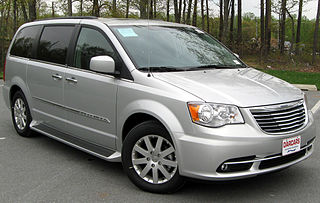
The RT-platform Chrysler minivans are a series of passenger minivans marketed by Chrysler starting in model year 2008, the fifth in six generations of Chrysler minivans. Depending on the market, these vans were known as the Dodge Grand Caravan, Chrysler Town & Country, Chrysler Grand Voyager, Lancia Voyager, Ram Cargo Van, and the Volkswagen Routan, a modified version sold by Volkswagen in North America. Only long wheelbase models were offered with the Dodge Journey replacing the short wheelbase model. While most versions were discontinued in 2016 with the launch of the Chrysler Pacifica minivan, the Grand Caravan remained in production until 2020. It was replaced by the sixth generation Chrysler Voyager, a new entry-level model based on the existing Chrysler Pacifica minivan.
Chrysler is an American brand of automobiles and division owned by Stellantis North America. The automaker was founded in 1925 by Walter Chrysler from the remains of the Maxwell Motor Company. The brand primarily focused on building luxury vehicles as the broader Chrysler Corporation expanded, following a strategy of brand diversification and hierarchy largely adopted from General Motors.


